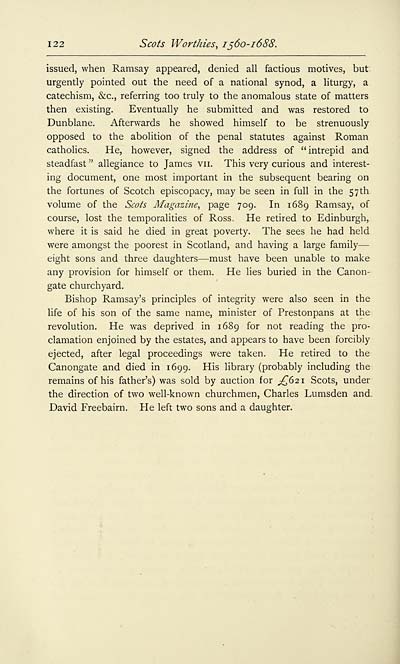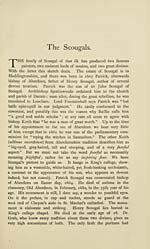Scots worthies, 1560-1688
(142) Page 122
Download files
Complete book:
Individual page:
Thumbnail gallery: Grid view | List view

122 Scots Worthies, 1 560-1688.
issued, when Ramsay appeared, denied all factious motives, but
urgently pointed out the need of a national synod, a liturgy, a
catechism, &c, referring too truly to the anomalous state of matters
then existing. Eventually he submitted and was restored to
Dunblane. Afterwards he showed himself to be strenuously
opposed to the abolition of the penal statutes against Roman
catholics. He, however, signed the address of "intrepid and
steadfast " allegiance to James vn. This very curious and interest-
ing document, one most important in the subsequent bearing on
the fortunes of Scotch episcopacy, may be seen in full in the 57th
volume of the Scots Magazine, page 709. In 1689 Ramsay, of
course, lost the temporalities of Ross, He retired to Edinburgh,
where it is said he died in great poverty. The sees he had held
were amongst the poorest in Scotland, and having a large family —
eight sons and three daughters — must have been unable to make
any provision for himself or them. He lies buried in the Canon-
gate churchyard.
Bishop Ramsay's principles of integrity were also seen in the
life of his son of the same name, minister of Prestonpans at the
revolution. He was deprived in 1689 for not reading the pro-
clamation enjoined by the estates, and appears to have been forcibly
ejected, after legal proceedings were taken. He retired to the
Canongate and died in 1699. His library (probably including the
remains of his father's) was sold by auction for ,£621 Scots, under
the direction of two well-known churchmen, Charles Lumsden and.
David Freebairn. He left two sons and a daughter.
issued, when Ramsay appeared, denied all factious motives, but
urgently pointed out the need of a national synod, a liturgy, a
catechism, &c, referring too truly to the anomalous state of matters
then existing. Eventually he submitted and was restored to
Dunblane. Afterwards he showed himself to be strenuously
opposed to the abolition of the penal statutes against Roman
catholics. He, however, signed the address of "intrepid and
steadfast " allegiance to James vn. This very curious and interest-
ing document, one most important in the subsequent bearing on
the fortunes of Scotch episcopacy, may be seen in full in the 57th
volume of the Scots Magazine, page 709. In 1689 Ramsay, of
course, lost the temporalities of Ross, He retired to Edinburgh,
where it is said he died in great poverty. The sees he had held
were amongst the poorest in Scotland, and having a large family —
eight sons and three daughters — must have been unable to make
any provision for himself or them. He lies buried in the Canon-
gate churchyard.
Bishop Ramsay's principles of integrity were also seen in the
life of his son of the same name, minister of Prestonpans at the
revolution. He was deprived in 1689 for not reading the pro-
clamation enjoined by the estates, and appears to have been forcibly
ejected, after legal proceedings were taken. He retired to the
Canongate and died in 1699. His library (probably including the
remains of his father's) was sold by auction for ,£621 Scots, under
the direction of two well-known churchmen, Charles Lumsden and.
David Freebairn. He left two sons and a daughter.
Set display mode to:
![]() Universal Viewer |
Universal Viewer | ![]() Mirador |
Large image | Transcription
Mirador |
Large image | Transcription
Images and transcriptions on this page, including medium image downloads, may be used under the Creative Commons Attribution 4.0 International Licence unless otherwise stated. ![]()
| Histories of Scottish families > Scots worthies, 1560-1688 > (142) Page 122 |
|---|
| Permanent URL | https://digital.nls.uk/95152730 |
|---|
| Description | A selection of almost 400 printed items relating to the history of Scottish families, mostly dating from the 19th and early 20th centuries. Includes memoirs, genealogies and clan histories, with a few produced by emigrant families. The earliest family history goes back to AD 916. |
|---|

